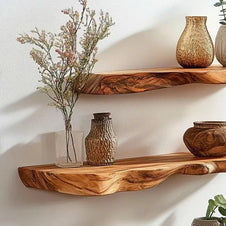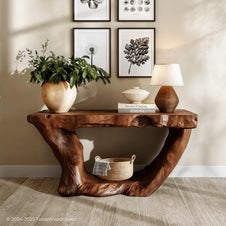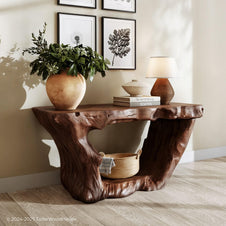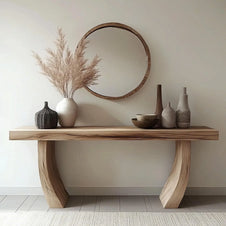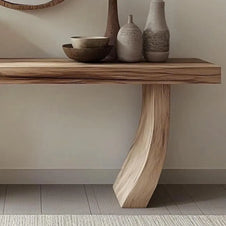Wondering how long should a shelf be on a wall? This guide covers ideal lengths, design tips, and safety insights for any room.
Why Shelf Length Matters More Than You Think
If you've ever stood in front of a blank wall, shelf in hand, asking yourself how long should a shelf be on a wall, you're not alone. It seems like a small detail, but choosing the right shelf length can make or break the functionality and aesthetics of a room. A shelf that’s too short might look awkward and underwhelming, while one that’s too long can overpower your space or risk sagging.
The length of a wall shelf impacts:
-
How it balances visually on your wall
-
What items you can place on it
-
How safe and stable it will be over time
-
Whether it matches the furniture and layout beneath it
So how do you get it right? Let’s break it down.
Standard Shelf Lengths for Different Spaces
Living Room & Lounge Areas
In general, shelves in living rooms span anywhere from 24 to 72 inches. A popular formula: cover about ⅔ of the wall’s total width. For example, if your wall is 90 inches wide, a shelf that’s 60 inches long will feel nicely proportioned.
Longer shelves in living rooms also provide space for layering design: framed art, candles, vases, or even a row of books arranged by color. If you're wondering how long should a shelf be on a wall for maximal styling impact, this is the room to be bold.
Bedroom & Reading Nooks
Here, shelves tend to be more compact. Aim for 24–48 inches, especially if you're mounting above a headboard or adding a shelf above a dresser. When in doubt, opt for symmetry with other furniture. For reading corners, combine shelf length with lighting considerations. A 36-inch shelf paired with a sconce or LED strip underneath makes for a cozy reading spot.
Kitchen Walls
Practicality rules here. For spices, short 12–24 inch shelves are great. For displaying dishes or glassware, you might go up to 36–48 inches—but remember, the longer it is, the stronger the support system needs to be. If you’re installing above a countertop or sink, ensure your shelf isn’t so long that it blocks access to cabinets or overhead lighting. The question how long should a shelf be on a wall becomes one of both utility and workflow.
Hallways & Entryways
In narrow spaces, subtlety wins. Choose lengths around 18–36 inches depending on the width of your wall section. Floating shelves are ideal here. These small shelves can be styled with catch-all trays, mirrors, or seasonal decor. Even short shelves can have a big design impact if placed thoughtfully. This variety proves one thing: the answer to how long should a shelf be on a wall depends heavily on the room’s function and size.

Looking for the perfect fit? Explore tree shelves with branch lengths made for living room scale.
How to Measure for the Right Shelf Length
When deciding how long should a shelf be on a wall, begin with a simple exercise:
-
Measure your wall’s width.
-
Multiply that by 0.6 to 0.75 to find a shelf length that looks balanced.
-
Leave at least 6–12 inches of space on either side of the shelf for breathing room.
Rule of Thirds
Designers often use the “Rule of Thirds” to position and size shelves. Placing shelves to align with a third of the wall’s width or height creates visual harmony.
Practical Test
Use painter’s tape to mock up the shelf’s size on the wall. Stand back. Does it feel right? If not, adjust. Your eye is a better judge than you think. Sometimes functionality is more important than strict symmetry.
You should also factor in nearby design elements: windows, doors, light switches, or art pieces. These can break visual lines and shift what length feels right.
Function First: What’s Going On the Shelf?
Another key to answering how long should a shelf be on a wall is to think about what the shelf will hold.
-
Books? Heavier items need more support. Stick to 24–48 inches with brackets every 16 inches.
-
Décor and plants? You can extend to 60–72 inches if the items are lighter and spaced out.
-
TV components or speakers? Measure devices first. Add extra inches for cords and visual spacing.
-
Artwork or photo frames? Make sure you give them breathing room.
Also think vertically: If you're stacking items, your shelf doesn't need to be long—it needs depth and strength. How long should a shelf be on a wall may not be as important as how it distributes weight.
Visual Balance & Design Tips
When wondering how long should a shelf be on a wall in terms of looks, consider the following:
-
Avoid odd overlaps. Don’t let shelves extend slightly past adjacent furniture (like a desk or couch). Either align fully or stay clearly within.
-
Group shelves smartly. A long shelf (60–72 inches) can feel more grounded than two short ones floating independently.
-
Mind the wall height. Taller walls can handle longer shelves, especially when placed higher.
Use shelves to complement—not compete with—your space. Also consider the height between shelves if you plan to stack them. Leave 10–12 inches vertically for books, 16–18 inches for large decor. For gallery walls, shelves can be styled to create rhythm and flow. Mix long and short shelves to guide the eye across the space.
 Tree bookshelf that follows all the visual balance and design tips in action.
Tree bookshelf that follows all the visual balance and design tips in action.
Tree-Shaped, Floating, or Bracketed?
Shelf type also affects your answer to how long should a shelf be on a wall.
-
Floating shelves (no visible brackets) are clean and modern but typically shorter (24–48 inches) unless reinforced.
-
Bracketed shelves can extend longer (up to 72 inches or more) with the right supports.
-
Tree-shaped or organic designs depend on artistic intention more than strict measurement. These are more flexible in form but should still align with visual balance.
Each type supports a different length range. Form follows function—and design. Think of the tree shelf as more than a shelf: it’s sculpture. Its branches may hold fewer items, but the artistic statement it makes adds immense value to the space.
Structural Safety: How Long is Too Long?
There’s no one-size-fits-all answer to how long should a shelf be on a wall, but there are limits:
-
Wood or MDF: Over 48 inches? Use multiple brackets or thicker wood (1+ inch).
-
Metal shelves: Can go longer, but the wall anchor strength is key.
-
Drywall-only installs: Limit to 36 inches unless you hit studs or use toggle bolts.
Also consider:
-
Wall type (drywall, brick, concrete)
-
Shelf depth and thickness
-
Frequency of use and loading weight
Use a level and heavy-duty anchors if the shelf is over 48 inches. And always pre-drill when mounting on studs.
Custom vs. Pre-Made Shelf Lengths
When shopping, you'll find standard shelf lengths of 24, 36, 48, and 72 inches. But what if your wall needs something different?
And of course, asking how long should a shelf be on a wall means you’re probably also curious about depth and mounting height.
Just remember: a shelf that fits your space, serves your function, and feels balanced to your eye is always the right choice.
 Wall tree Bookshelf that fits your space, serves your function, and feels balanced
Wall tree Bookshelf that fits your space, serves your function, and feels balanced
Don’t Forget: Style Affects Perception of Length
A sleek white shelf will often appear longer than a thick, rustic wooden plank of the same length. Visual weight is real.
Choose your material and finish with care:
-
Light-colored or minimal edges feel longer
-
Chunky textures shorten visual stretch
-
Black shelves often anchor the room more firmly
This means the perceived answer to how long should a shelf be on a wall depends not only on inches—but also style.
Mirrors nearby can also influence perception. A shelf beneath a mirror often looks shorter than the same shelf on a plain wall.
Real-Life Examples
-
A 72-inch reclaimed wood shelf above a couch in a modern farmhouse living room feels grounded and intentional.
-
A 36-inch black metal floating shelf in a minimalist bedroom serves as a perfect perch for books and trailing plants.
-
Three 24-inch oak shelves stacked vertically in an entryway bring warmth and functionality to a tight space.
-
A 48-inch shelf in a kitchen, set just above the backsplash, adds storage without clutter.
-
Two 30-inch wall-mounted shelves in a bathroom hold towels and toiletries without making the room feel boxed in.
-
A 60-inch shelf mounted above a desk doubles as decor and workspace storage, especially when styled with framed prints and lighting.
Each scenario solves the question how long should a shelf be on a wall in its own unique way—guided by proportion, purpose, and personality.

Explore our standard-length tree bookshelves for a well-proportioned fit in any space.
Final Thoughts: So, How Long Should a Shelf Be on a Wall?
Here’s the bottom line: There’s no single “perfect” length—but there is a “right” one for your wall.
When asking how long should a shelf be on a wall, consider your:
-
Wall width and height
-
Purpose of the shelf
-
Type of support and wall material
-
Desired visual effect
-
Room function and existing furniture layout
-
Visual weight and material tone
If you follow the ⅔ wall-width rule, align with use case, and anchor safely, you’ll land on the right shelf length with confidence.
In the end, it’s not just about measurement—it’s about making space feel right, look beautiful, and serve you well. And now that you understand how long should a shelf be on a wall, you’re one step closer to designing a space that truly feels like home.


